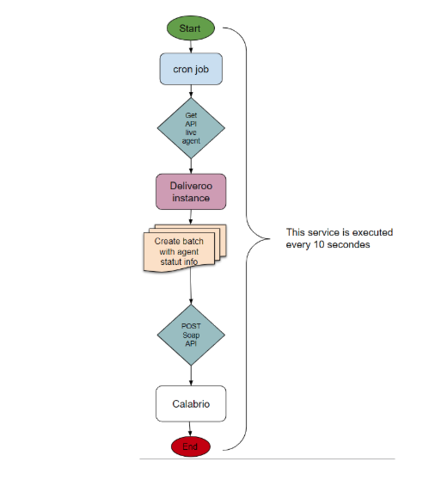ZIWO Integration with Calabrio
Overview
Integrating ZIWO with Calabrio (a workforce optimization and contact center software platform) allows you to combine ZIWO’s communication capabilities with Calabrio’s advanced workforce management and analytics features. This integration can help improve customer service operations, enhance call center performance, and provide deeper insights into both agent and customer experiences.
Here’s an overview of the features, version compatibility, and requirements for integrating ZIWO with Calabrio.
Features
- Call Logging and Analytics: Automatically capture and log all customer interactions (calls, messages, chats) in Calabrio. This enables advanced reporting and analytics, giving insights into call volume, handling times, customer satisfaction, and more.
- Real-time call analytics: Track KPIs such as average call duration, service level, and first-call resolution through Calabrio’s analytics dashboard, with data from ZIWO.
- Workforce Management (WFM): Automatically feed ZIWO’s call center data into Calabrio WFM for better workforce scheduling and real-time performance management. Calabrio’s WFM features can optimize agent scheduling based on call volume, handling times, and customer interaction trends.
- Forecasting and Scheduling: Calabrio can use data from ZIWO to forecast call volumes and create optimized schedules for agents. This ensures that the right number of agents are available at peak times.
- Quality Management and Performance Monitoring: Use Calabrio’s Quality Management tools to evaluate call recordings and interactions captured in ZIWO. This helps managers assess agent performance based on customer interactions.
- Call Recording and Evaluation: Integrate ZIWO’s call recording functionality with Calabrio’s evaluation tools to assess agent behavior, call quality, and customer satisfaction.
- Advanced Reporting and Dashboards: Calabrio’s powerful reporting tools can pull ZIWO data to create customized reports and visual dashboards. These reports can include metrics like call center performance, agent productivity, customer experience ratings, etc.
- Workforce Insights: Combine ZIWO call data with Calabrio’s workforce data to generate insights about agent efficiency, call-handling times, and overall productivity.
- Real-Time Monitoring: Live Monitoring: With this integration, managers can monitor real-time ZIWO call activity directly from Calabrio’s interface. This includes seeing who’s on a call, how long they’ve been on, and if they’re meeting predefined KPIs like service level targets.
O (such as call disposition, reason codes, etc.) with Calabrio for more comprehensive reporting and performance evaluation.
Key Points
- Lead Time to Install : Around 30 minutes.
- Supported Versions: Calabrio
- App name and marketplace Link: https://www.calabrio.com/
Versions and Compatibility
- Lead Time to Install : Around 5-10 minutes.
- Supported Versions: Reporting integration
- App name and marketplace Link:
- ZIWO Call Center Functionality: ZIWO’s version should support the communication channels you wish to integrate, such as voice, chat, SMS, or email. Ensure your version of ZIWO supports multi-channel contact center operations.
- Integration Version Compatibility: Check both platforms for compatibility between the API or integration methods used by ZIWO and Calabrio. For example: APIs: If both ZIWO and Calabrio support REST APIs, ensure that they are compatible in terms of data formats and authentication methods.
- Webhooks: ZIWO can send webhook data to Calabrio, so ensure that the webhook URLs are properly configured to accept data from ZIWO in real-time.
Technical Requirements:
- ZIWO API: You need access to ZIWO’s API to send interaction data such as call logs, chat interactions, and agent data to Calabrio.
- Calabrio API: You will need Calabrio’s API access for pushing and pulling data. Calabrio’s API can handle real-time monitoring, workforce management, and analytics.
- Data Formats and Security: Ensure that the data formats used by ZIWO (such as JSON, XML, etc.) are compatible with Calabrio’s data ingestion requirements.
- Security: Implement secure authentication methods for the API or webhook integrations, such as OAuth or API keys, to ensure that data flows securely between ZIWO and Calabrio.
Flow Diagram and working
- It stores the real time and historical data on the dashboard and it run in the interval of 10 secs.
- After every 10 seconds , the data will get stored.

- It stores all the below information:
- Queue Information
- Integer for aggregation depth (in minutes), should be the same for all the rows in the file. 15 minutes.
- Logging date
- Start time for the logging interval
- The queue’s unique numeric identifier
- Original queue name or definition in the platform
- Inbound items to this queue, this queue being the original receiver
- Number of lost/abandoned items
- Number of answered items on the queue
- Total talk time for all answered items (in seconds)
- Total wrap-up time/after call work, associated with queue items, within the interval
- Number of items answered within service level
- Agent Information
- Integer for aggregation depth (in minutes), should be the same for all the rows in the file. 15 minutes.
- Logging date
- Start time for the logging interval
- Unique agent identifier in the platform
- Agent name in CTI
- Total productive time (if not defined in the platform, then tot_work_dur - pause_dur) (in seconds)
- Total time logged in during an interval (in seconds)
- Total time in pause mode (in seconds) exclusive wrap_up_dur
Conclusion
The ZIWO and Calabrio integration provides powerful tools for managing customer interactions, optimizing workforce performance, and enhancing call center analytics. By syncing call data, performance metrics, and customer feedback, this integration enables contact centers to improve both operational efficiency and the overall customer experience.
.